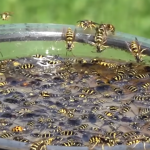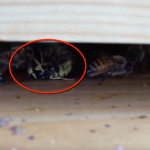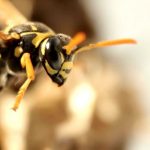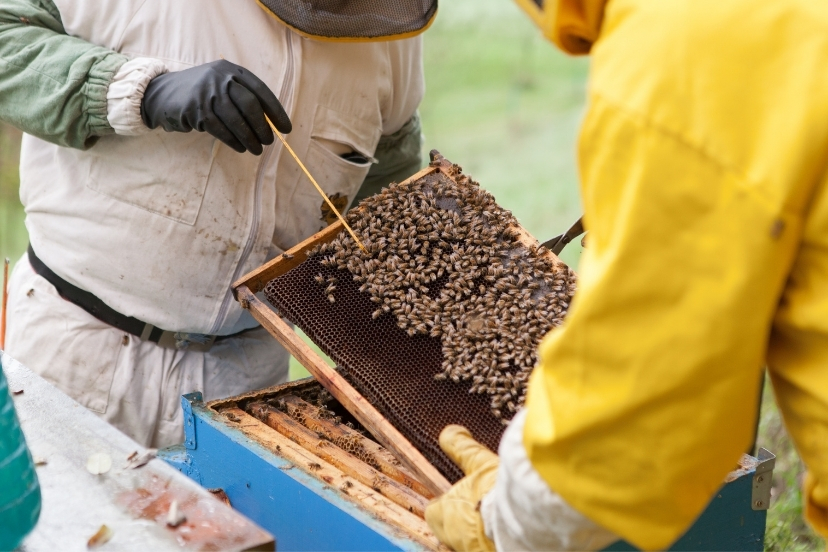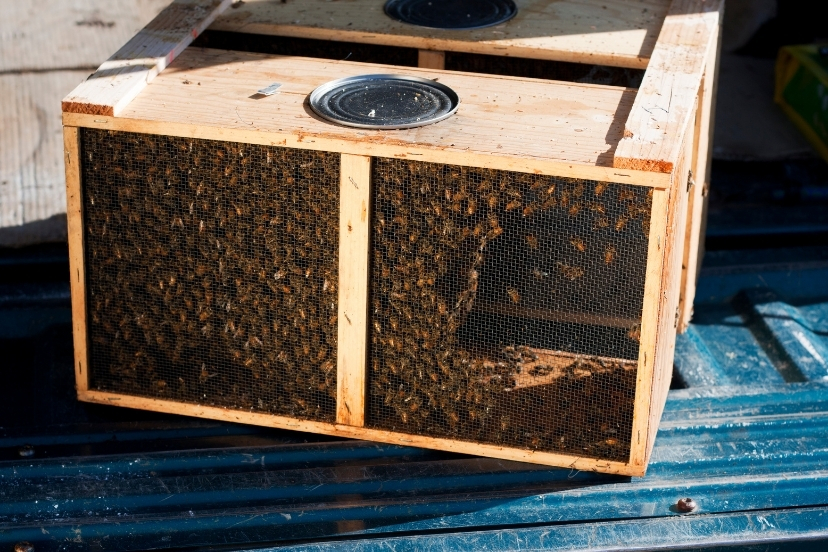After watching wasps nearly decimate my first hives fifteen years ago, I’ve made it my mission to find effective, bee-safe ways to protect colonies.
Let me tell you, learning these techniques hasn’t been easy, but these methods have saved countless colonies over the years.

Understanding Wasp Behavior and Prevention Basics
Wasps are smart, persistent predators that become increasingly aggressive as summer transitions to fall.
I’ve spent countless hours observing their patterns, and here’s what you need to know: they typically scout in the early morning, between 6-9 AM, and launch their main attacks during the warmest parts of the day.
What makes wasps particularly challenging is their ability to remember food sources. Once they find your hives, they’ll keep coming back unless you take action.
I learned this the hard way when a single scout led to an entire nest targeting one of my strongest colonies. By the time I noticed what was happening, the wasps had already established a regular hunting pattern.
If you’re dealing with an active wasp problem, take a look at my comprehensive guide on protecting your honey bee colonies from wasp attacks for immediate action steps.
Physical Barriers and Modifications
Last summer, I watched in amazement as my strongest colony successfully defended itself against wasps thanks to a combination of physical barriers. The key is creating a defensive system that works with your bees’ natural behaviors.
Essential barrier modifications include:
- Install robbing screens by mid-July
- Reduce entrances to 1-inch maximum
- Add upper entrances for better ventilation
- Install landing boards at 45-degree angles
- Use entrance reducers with multiple small holes
One of my most successful modifications was installing a specialized landing board that forces wasps to approach from below while allowing bees to land naturally. The difference in predation attempts was dramatic – nearly a 70% reduction in the first week alone.
Smart Trap Placement Strategies
Through careful observation and countless adjustments, I’ve developed a two-zone defense system that has proven remarkably effective. The key is understanding that wasps follow specific flight patterns and prefer certain heights for hunting.
Primary Defense Zone (5-10 feet from hives):
- 4 traps at compass points
- Elevated 4-5 feet off ground
- Yellow pan traps with soapy water
- Replaced every 3 days
Secondary Defense Zone (15-20 feet from hives):
- 6-8 bottle traps with fermented bait
- Varied heights from 3-8 feet
- Changed weekly
- Positioned near wasp flight paths
The most dramatic improvement came when I started paying attention to local wind patterns. By placing traps upwind of the hives, I intercepted many wasps before they even reached my colonies.
Creating a Wasp-Resistant Environment
Your apiary’s landscape can be your strongest ally in wasp defense. After years of experimentation, I’ve discovered that certain plant combinations create an invisible barrier that wasps prefer to avoid.
Near Hive Plants:
- Marigolds (French varieties work best)
- Pennyroyal
- Spearmint
- Citronella grass
- Eucalyptus (in containers)
The real magic happens when you plant these in strategic groupings. I’ve found that creating three distinct rings of protection works best.
The inner ring, closest to the hives, consists mainly of low-growing herbs like thyme and mint. The middle ring features taller plants like marigolds and citronella grass, while the outer ring includes the largest plants like eucalyptus and rosemary.
This layered approach not only deters wasps but also provides year-round benefits for your bees. The succession of blooms offers additional forage, while the varying heights create beneficial microclimates around your hives.
Natural Deterrent Solutions
I’ve tested dozens of natural deterrents over the years, and essential oils have consistently proven most effective.
The key is understanding that different oils serve different purposes – some repel wasps directly, while others mask the attractive scent of honey and bee pheromones.
Through extensive testing in my own apiaries, I’ve found that combining multiple essential oils creates a more effective barrier than using any single oil alone.
The synergistic effect seems to confuse wasps’ sensory systems while remaining gentle on the bees.
Primary Deterrent Spray:
- 15 drops peppermint oil
- 10 drops citronella oil
- 8 drops eucalyptus oil
- 2 drops clove oil
- 1.5 cups unscented witch hazel
- 1/2 cup distilled water
- 1 teaspoon vegetable glycerin (helps oils bind)
The glycerin was a game-changing addition I discovered after months of dealing with separation issues. Not only does it keep the oils mixed longer, but it also helps the mixture stick to surfaces better, especially during humid conditions.
Secondary Barrier Spray:
- 20 drops lemongrass oil
- 15 drops rosemary oil
- 10 drops tea tree oil
- 2 cups white vinegar
- 1 cup water
This second mixture creates an excellent perimeter defense. I spray it on fence posts, hive stands, and nearby vegetation – anywhere but the hives themselves. The vinegar base helps it last longer in wet weather, which we get plenty of in my area.
Commercial Products and Applications
Over the years, I’ve tested numerous commercial wasp deterrents, and I’ve found that certain products stand out for their effectiveness and bee safety. The key is looking for products that use natural repellents rather than toxic ingredients. Commercial products are always a last resort for me because I don’t like using them.
When selecting commercial deterrents, prioritize these features:
- Natural pyrethrin-free formulations
- No synthetic pesticides
- Clear bee-safe labeling
- Long-lasting effectiveness
- Weather-resistant properties
Application timing is crucial when using commercial products. I’ve found early morning applications, before both wasps and bees become active, work best. Only use these if necessary and always test new products on a small scale first and observe your colonies’ behavior for at least 48 hours afterward.
Safety Considerations
When implementing any wasp deterrent strategy, safety must be your top priority. I learned this lesson the hard way after a particularly aggressive wasp encounter left me with multiple stings despite wearing what I thought was adequate protection.
Personal Protection:
- Wear full bee suit during applications (consider having a separate suit used only for commercial products)
- Use chemical-resistant gloves
- Protect eyes with sealed goggles
- Apply during calm weather
- Keep first aid kit nearby
Bee Safety Protocol:
- Monitor for adverse reactions
- Ensure adequate ventilation
- Test products on small areas first
- Keep detailed application records
- Maintain clean water sources
Maintaining Your Defense System
Success against wasps requires consistent attention and adjustment. I spend about 30 minutes each morning checking my defenses and making necessary adjustments.
This investment of time has paid off tremendously in reduced colony losses and stronger hives overall.
Daily monitoring should include:
- Checking trap effectiveness
- Observing bee behavior
- Inspecting physical barriers
- Refreshing deterrent applications
- Recording wasp activity levels
Long-Term Success Strategies
The most effective wasp deterrent strategy combines multiple approaches while remaining flexible enough to adapt to changing conditions. I’ve found that success comes from consistency and observation rather than relying on any single method.
Remember that what works in one season might need adjustment in the next. Keep detailed records of what works and what doesn’t in your apiary. Over time, you’ll develop a personalized system that works perfectly for your specific situation.
The effort you put into protecting your bees from wasps will pay dividends in stronger colonies and better honey production. Stay vigilant, keep learning, and always prioritize the well-being of your bees.


